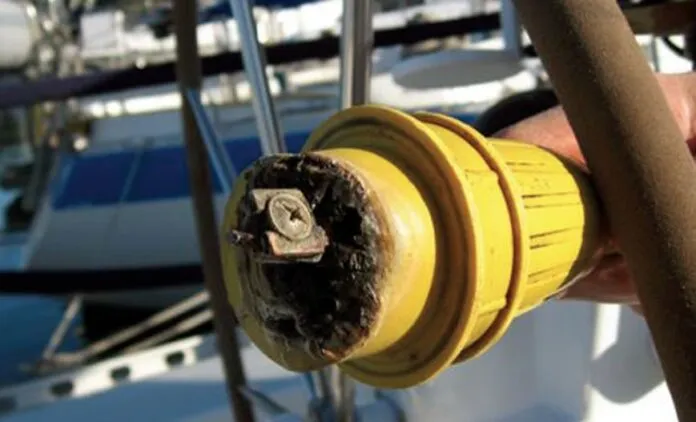One of the often overlooked maintenance items in the pre-season rush to the water is the AC shorepower system. Over the years of surveying, I’ve amassed a small collection of scary photos from past surveys showing the common examples of neglect to this critical system.
Barring improper use or some owner fabricated MacGyverism gone bad (jury-rigged adaptors, botched plug installations, etc.) overheating and corrosion are the primary causes of AC shore power cord problems. Charred plugs and receptacles are the most common and are a result of resistance build up due to loose or corroded connections, which in turn generate heat and the potential for fire. The problem is especially prevalent among boats that continually run high energy loads such as water heaters and air conditioning units.
Basic inspections of your AC shore power system are easily accomplished and are well within the ability of any boater. The first step is securing all AC power to avoid accidental shock hazards. Turn off your boats main AC breaker, then the shore pedestal breaker. Next unplug the shore power cord and verify that all other sources of power (such as power on-demand generators and DC to AC inverters) are turned off and their respective breakers secured in the off position.
Start your inspection with the shore power cord itself, ensuring its constructed of proper marine grade components, uses appropriately sized wiring, and is the shortest cord that will get the job done. Always replace cords that show signs of chafe, cracks, split insulation, or those having electrical tape repairs.
Industry standards call for shore cords to have molded-on plugs with sealing flanges or appropriate weatherproof boots. The plugs themselves should be checked each time you disconnect shore power (prior to getting underway for example) or monthly at a minimum, particularly for discoloration or corrosion on or around pins and plug inlets.
By the time discoloration is visible at the front of a plug or inlet, you’ll typically find that the damage is greater upon opening up the back for inspection. If left uncorrected, the damage will snowball (due to increasing resistance and heat buildup) until it burns a hole through the face of the plug, possibly leading to a fire.
When inspecting your shore power cord its also crucial to check the dock pedestal outlet and your boats inlet receptacle, ensuring both are corrosion free and undamaged. Upon finding a charred power cord plug, many owners simply replace it or the cord itself, only to find the new one shorts out due to a burned dock receptacle or inlet.
Another good practice is checking the feel of the connection when plugging in. Those that feel loose or don’t seem to be making firm mechanical contact likely won’t provide good electrical contact either. Avoid using worn or damaged pedestal plugs and report them to marina personal as soon as possible.
Practical Sailor has looked at a variety of smart plugs that warn owners of problems. These include the SmartPlug (PS, June 2010), which watches for shorts, and the West Marine GalvanAlert (PS, October 2009), which checks for wiring defects and reverse polarity. For more on AC safety, see our five-volume eBook series Marine Electrical Systems, found at www.practical-sailor.com/books.








































This is an excellent article. Twice I have discovered burned plugs on the boat receptacle. I determined that this is the result of crew stepping on the plug and stressing the connection. The repair required replacing both the shore power cord and the receptacle. The location of the receptacle is poorly positioned near the boarding gate on my Island Packet 35. In both instances I was using the new EEL connectors. I like them a lot but do not feel they provide the same connection strength as the typical screw in collar. I plan on building a step cover over the connection to prevent this from happening, as well as regular inspections as the author recommends.
Excellent article. Marina operators also need to inspect their pedestals on a regular basis – I have seen a number of these (in various marinas in several states) where the outlets were in very poor condition.